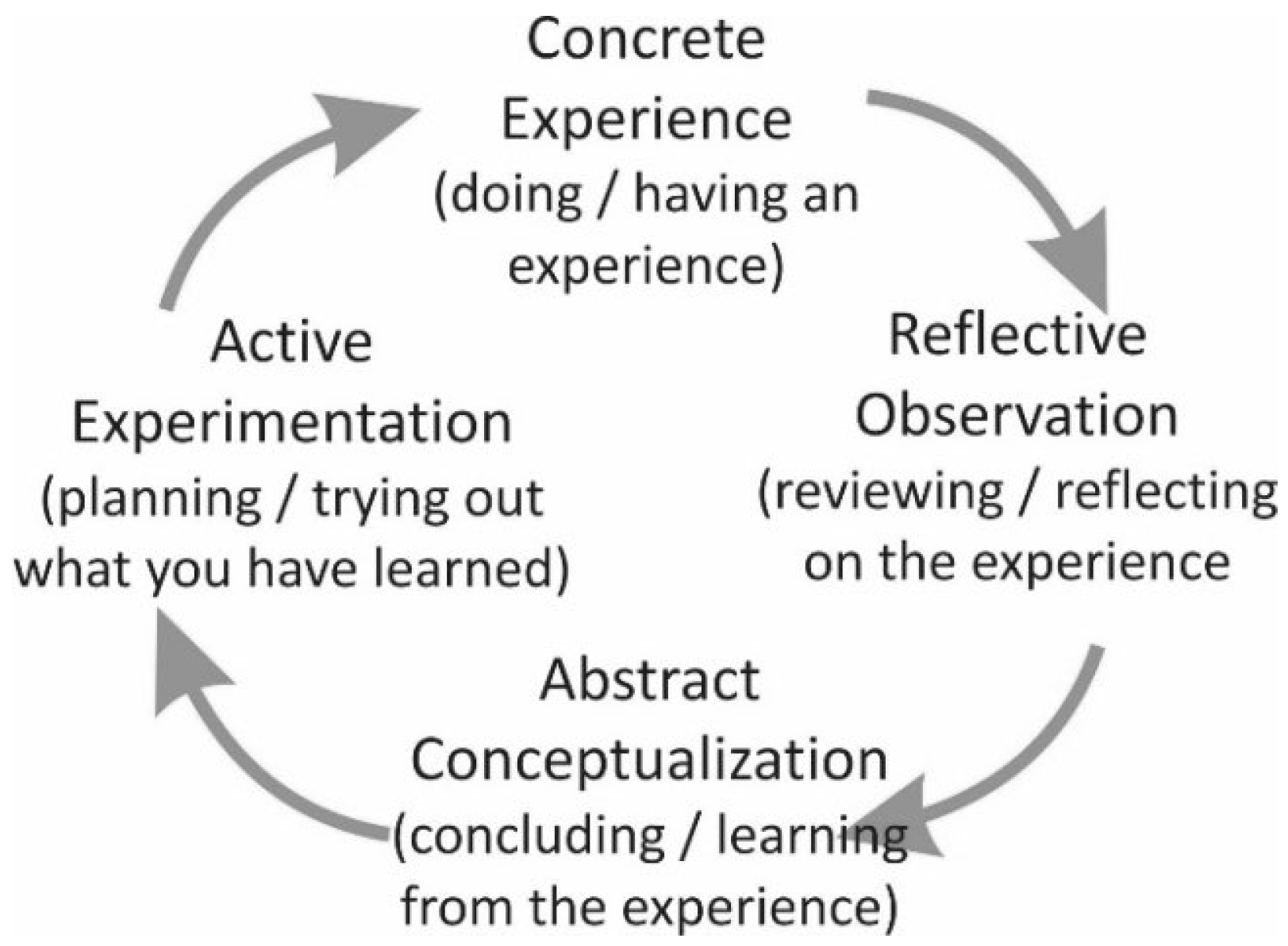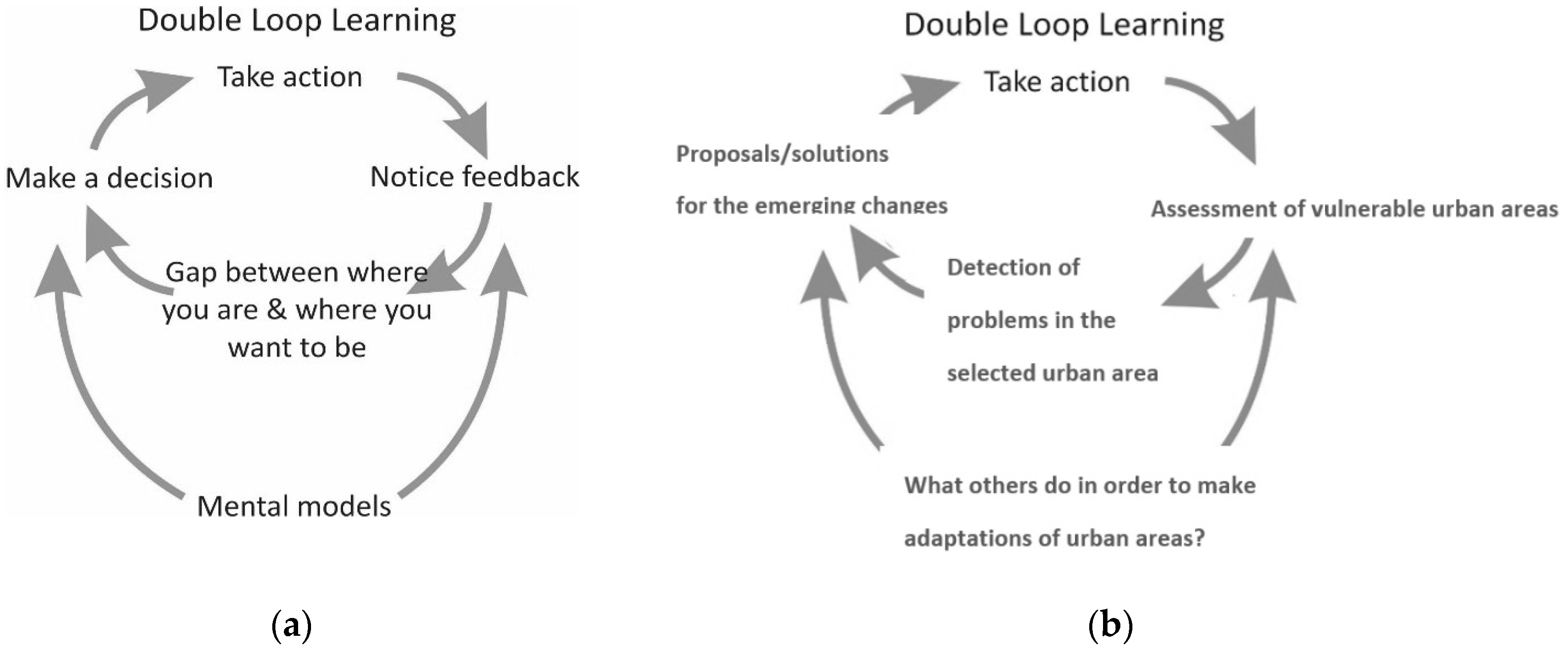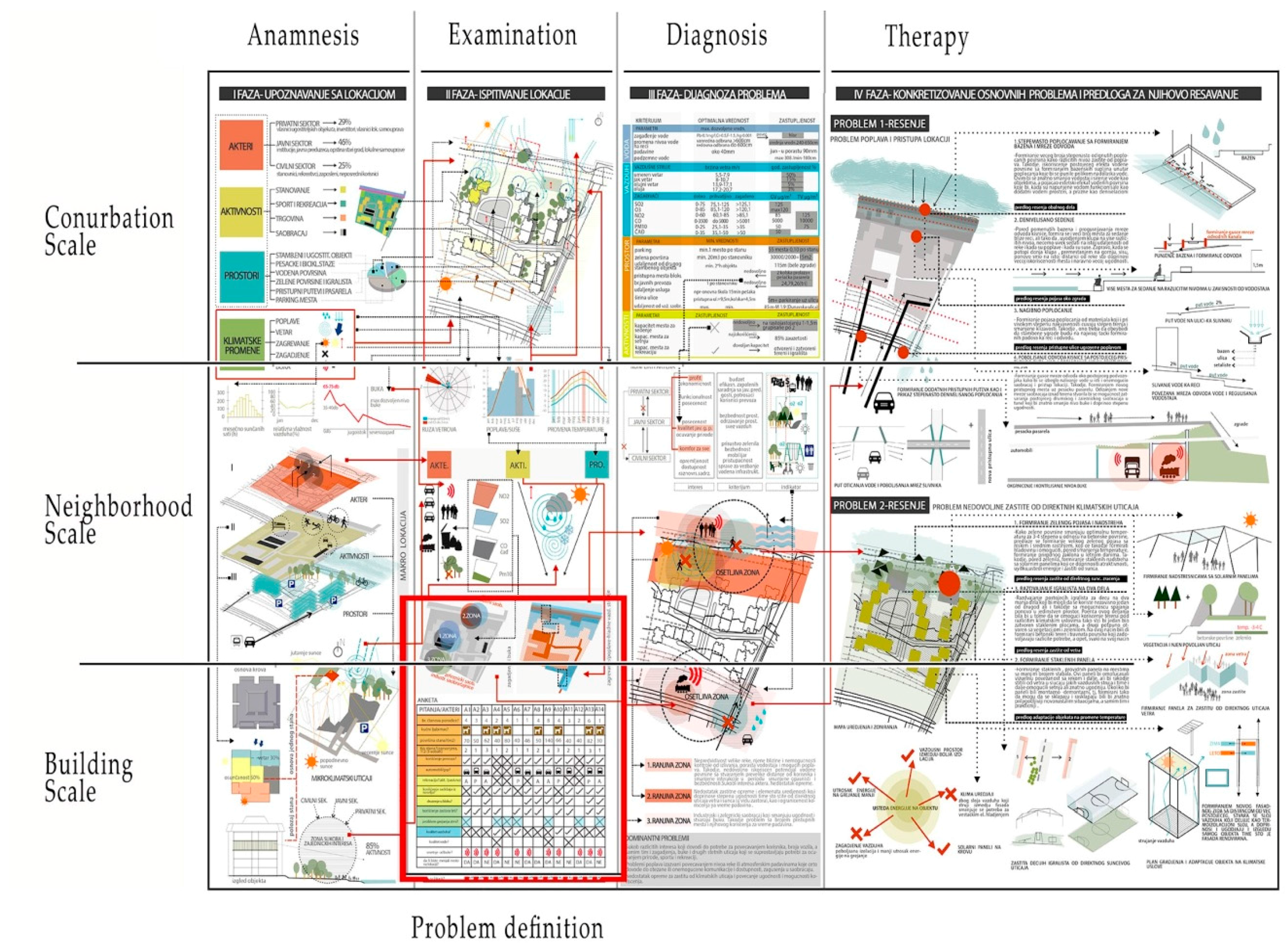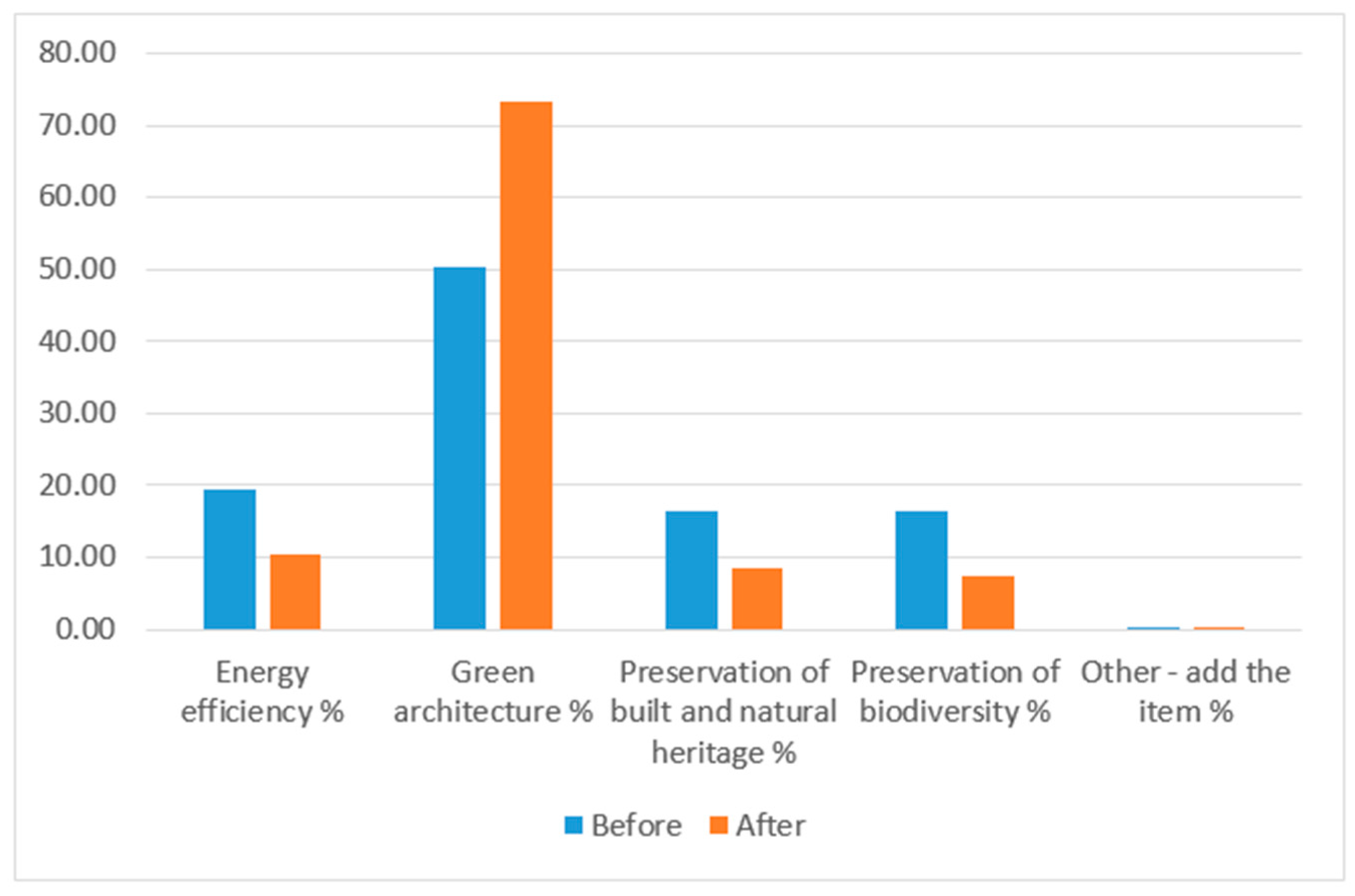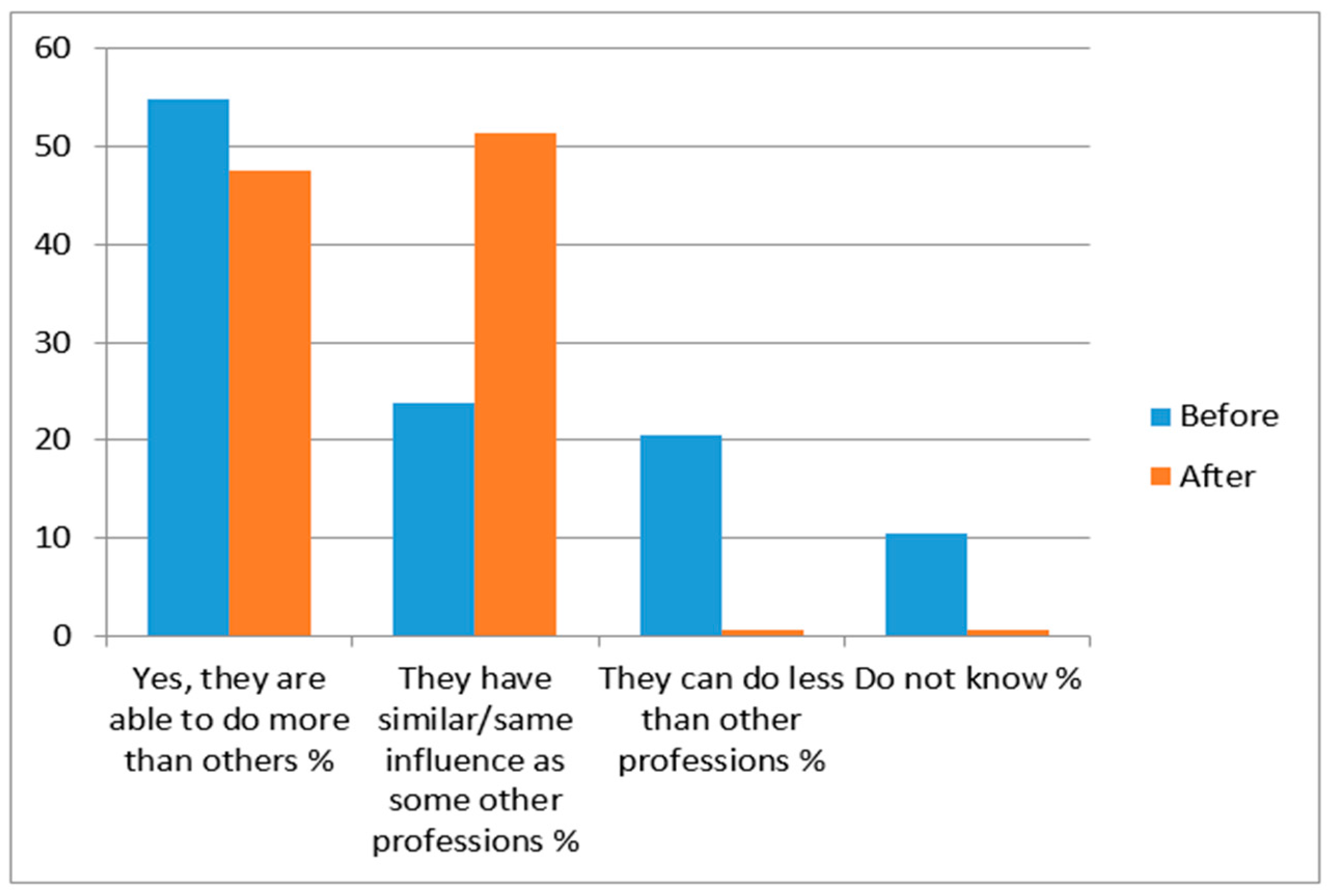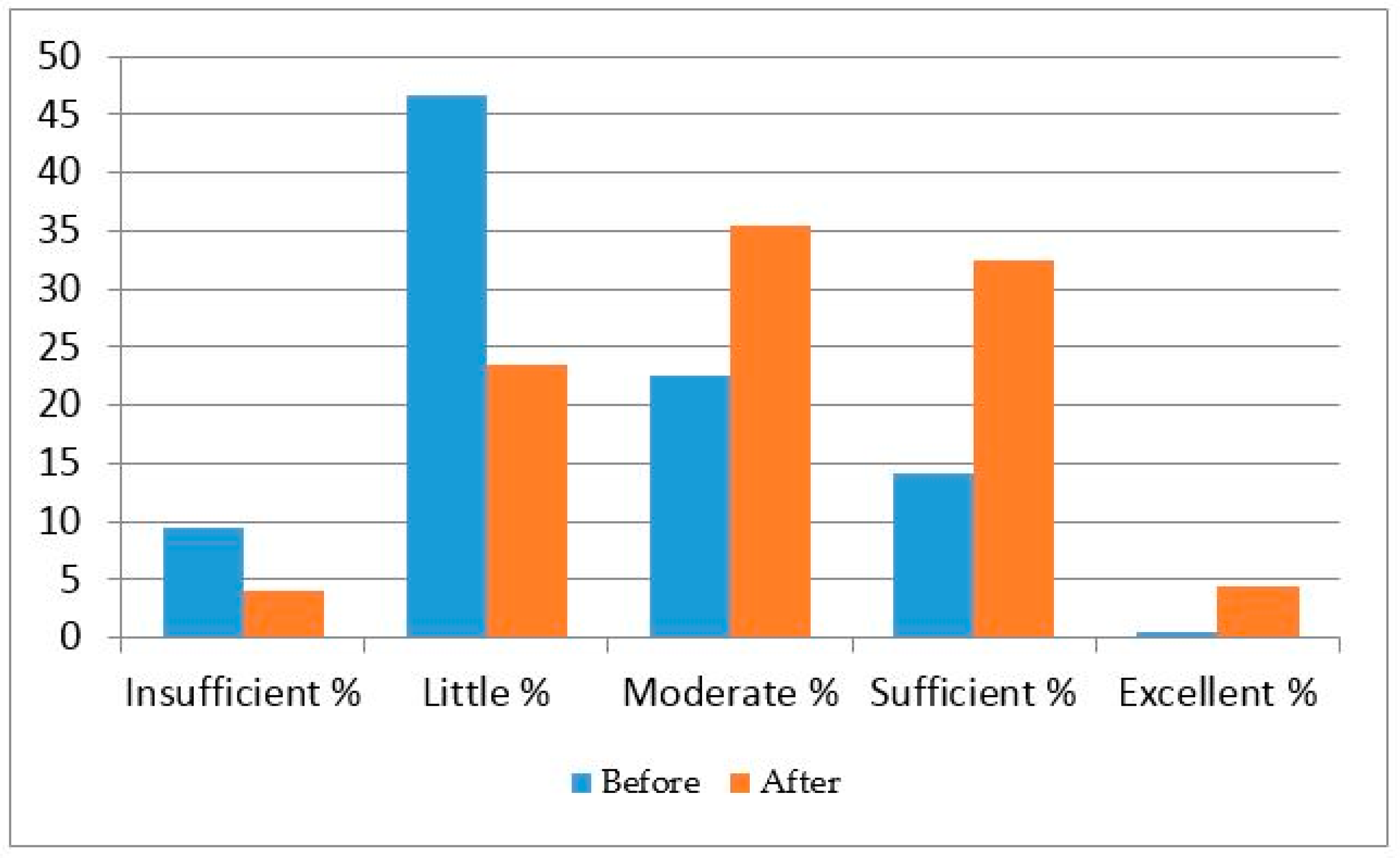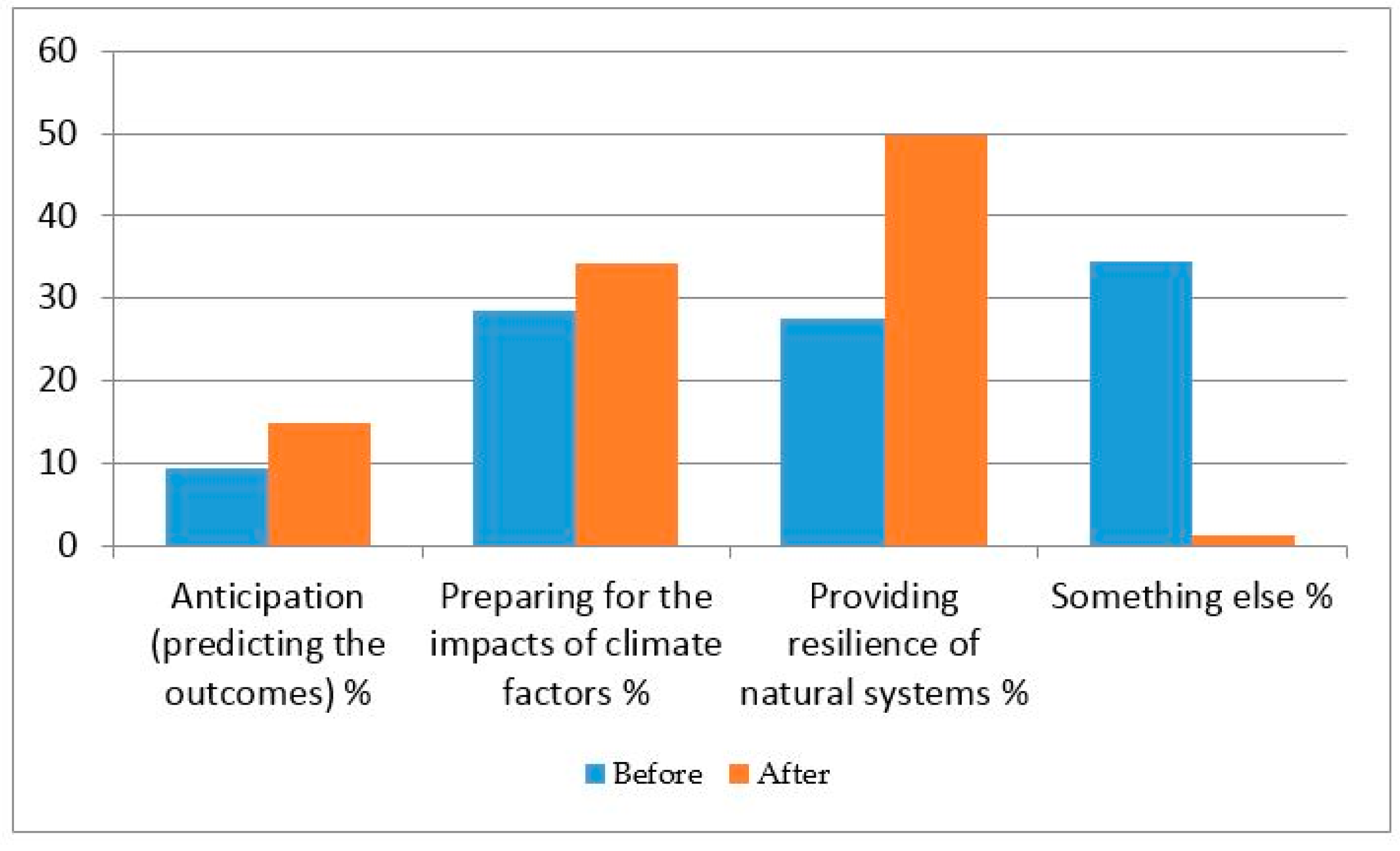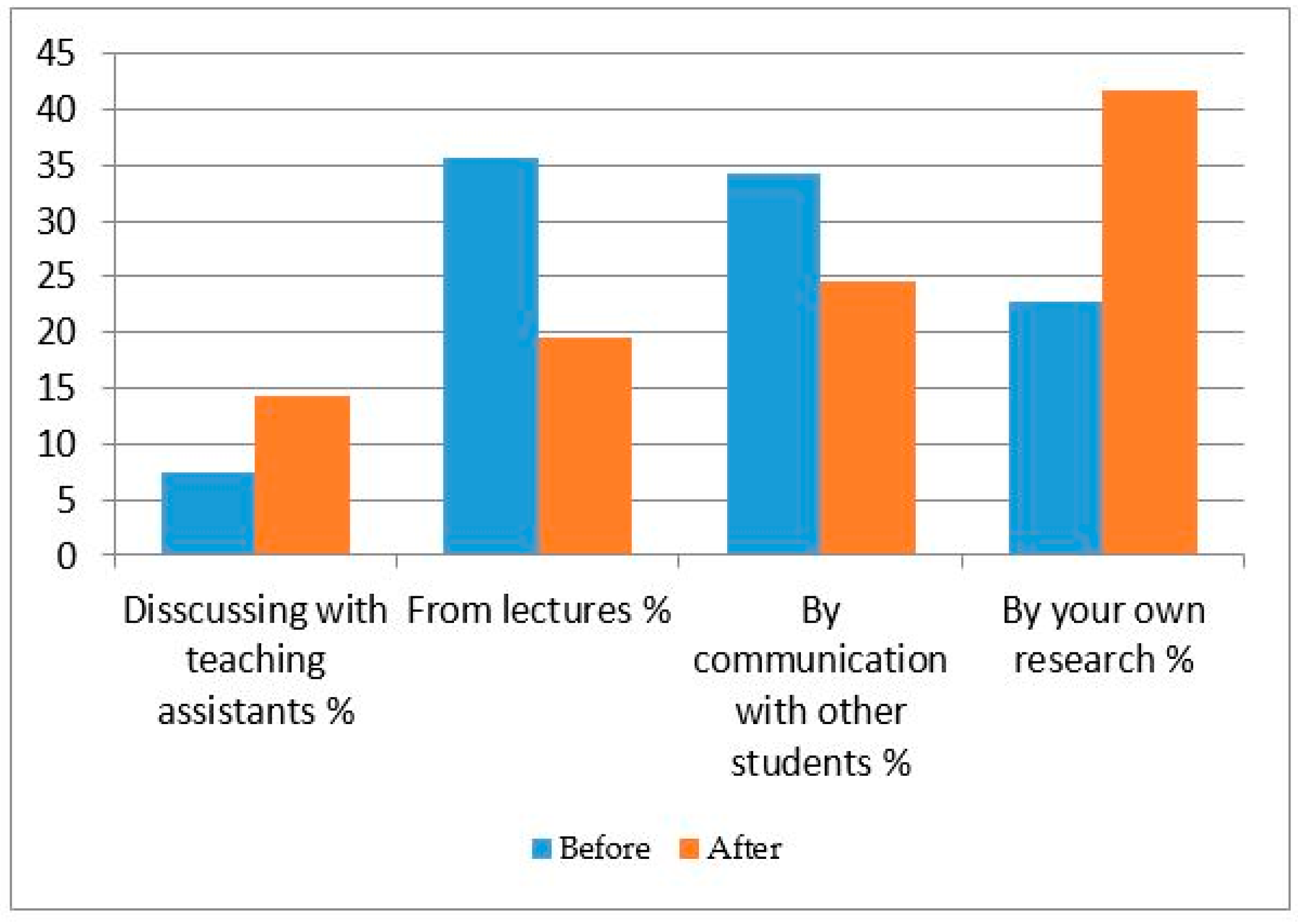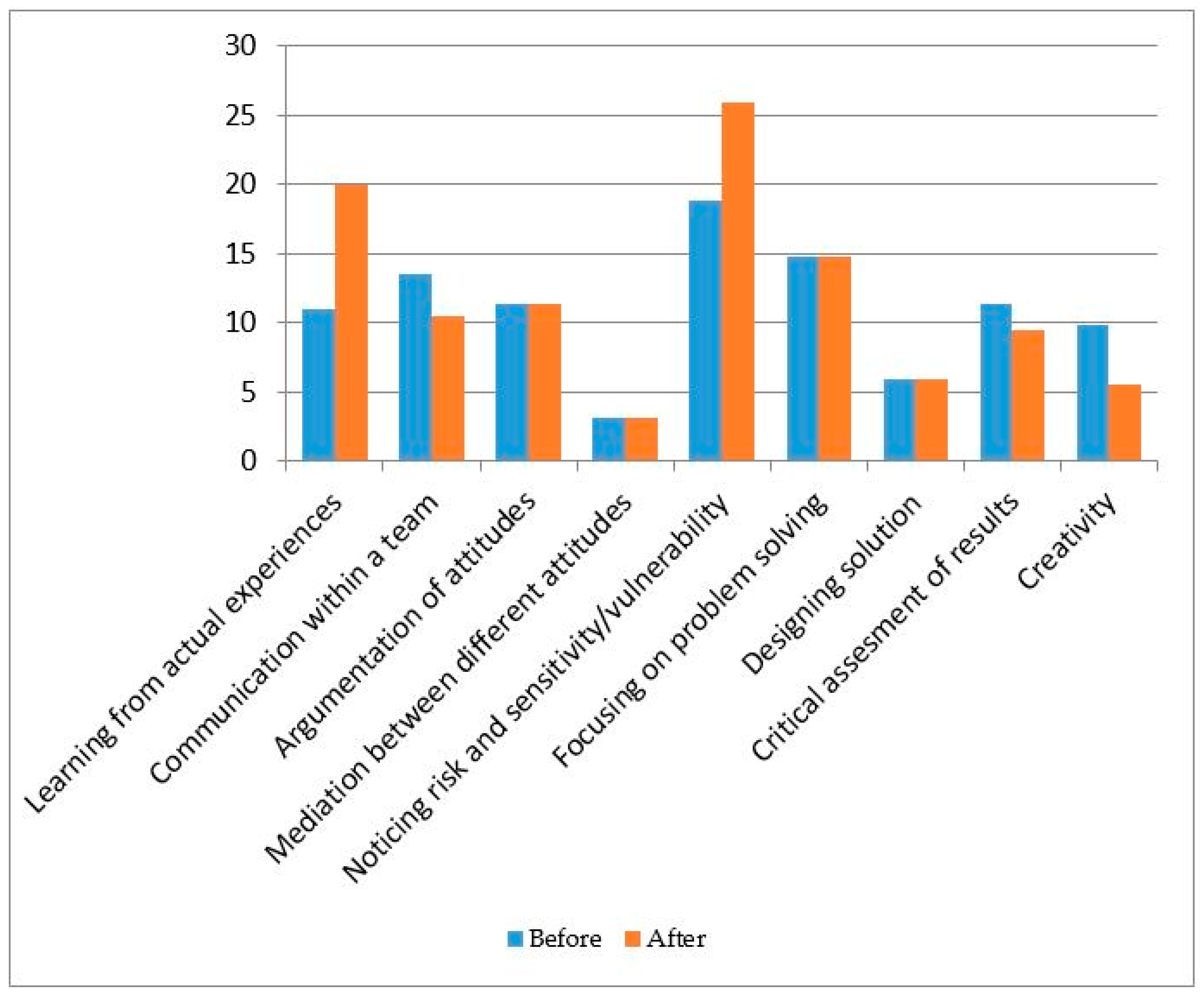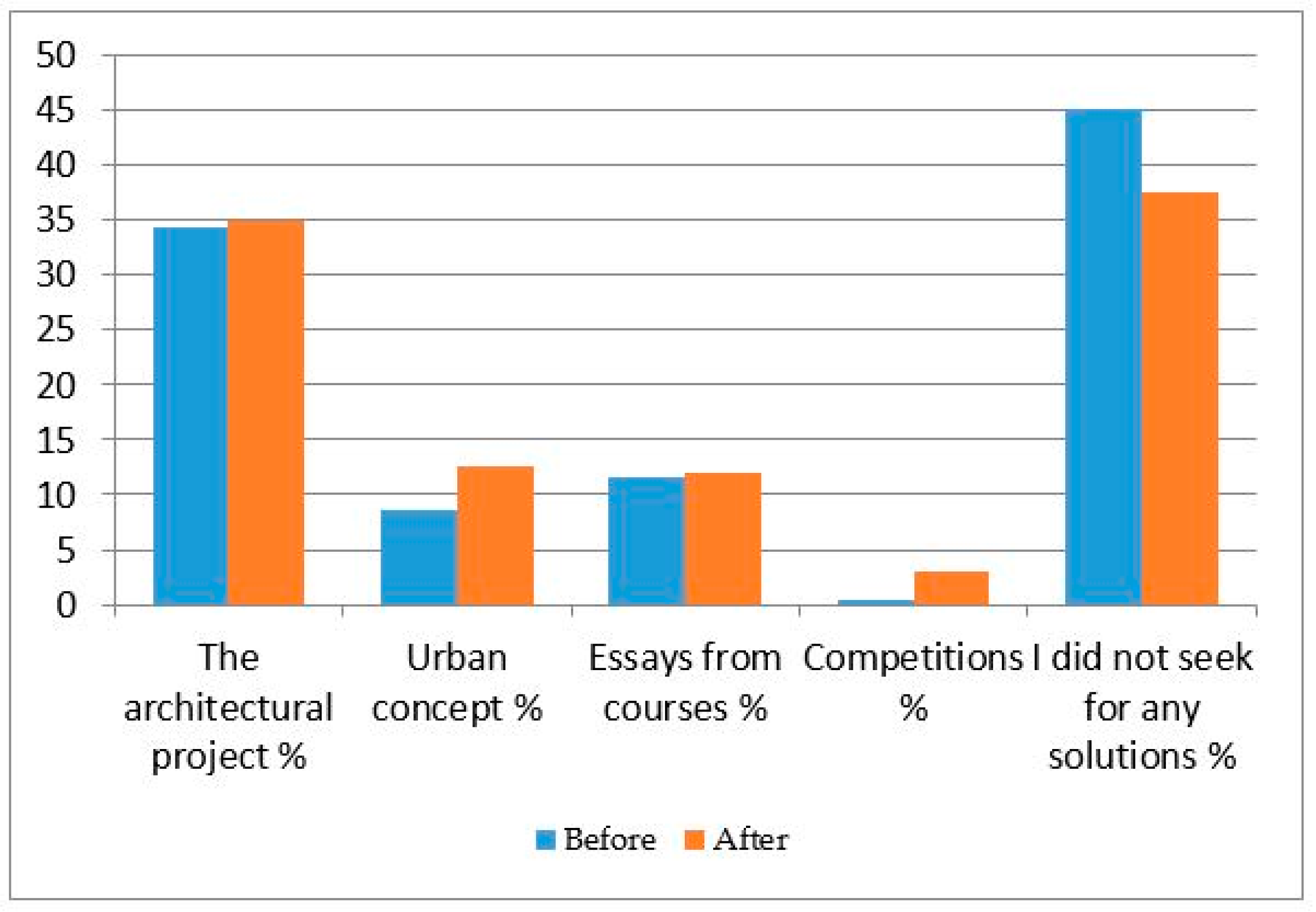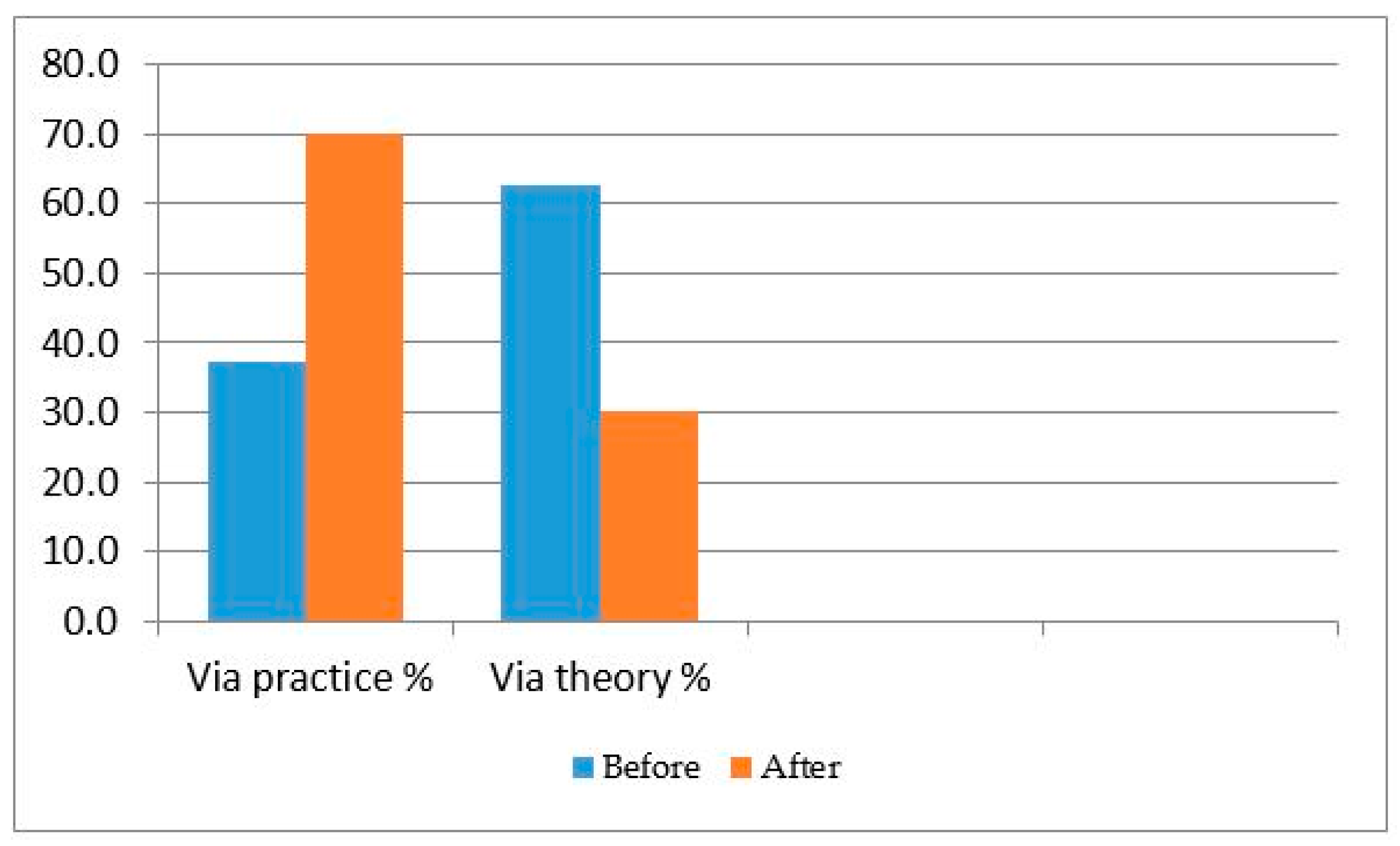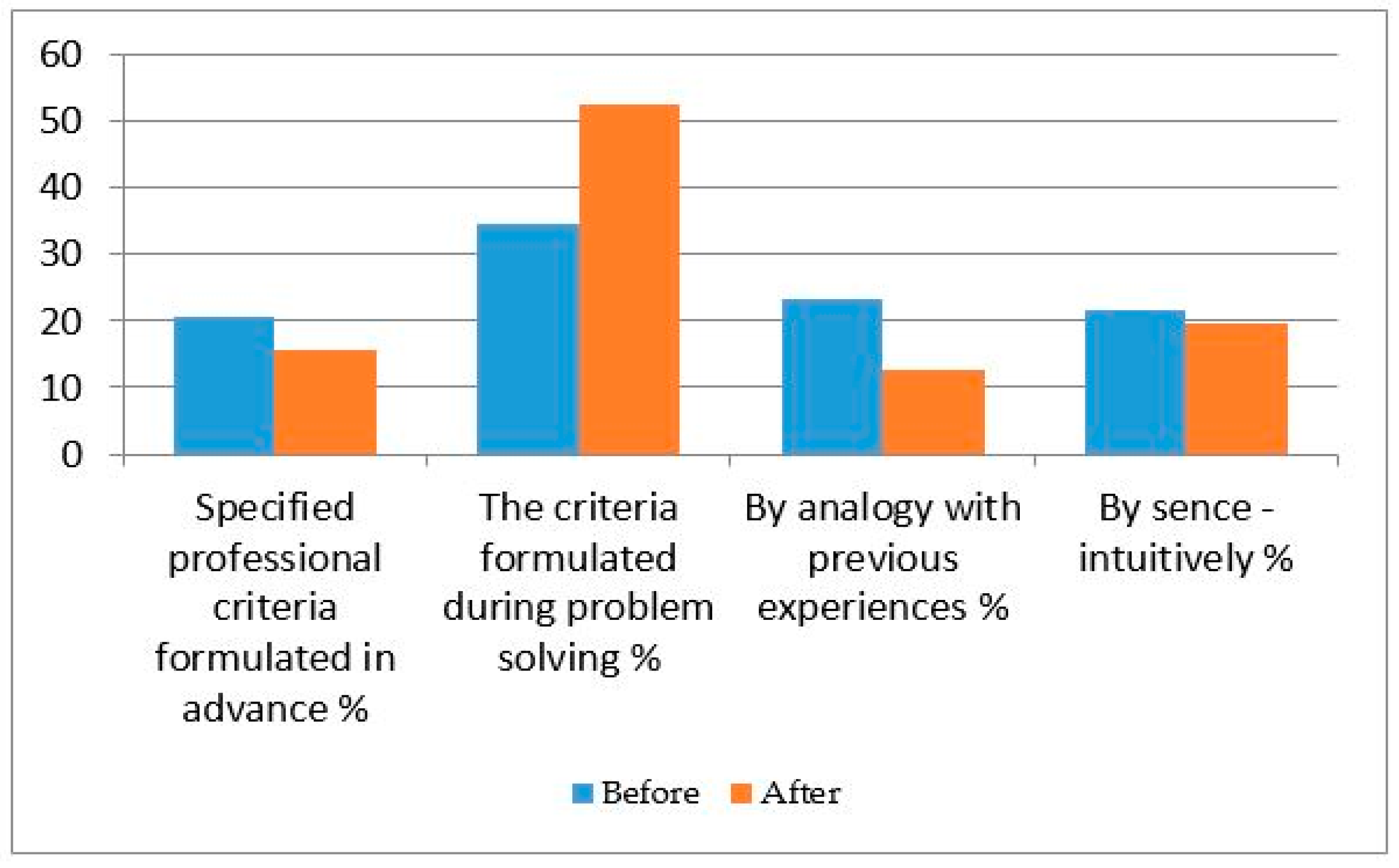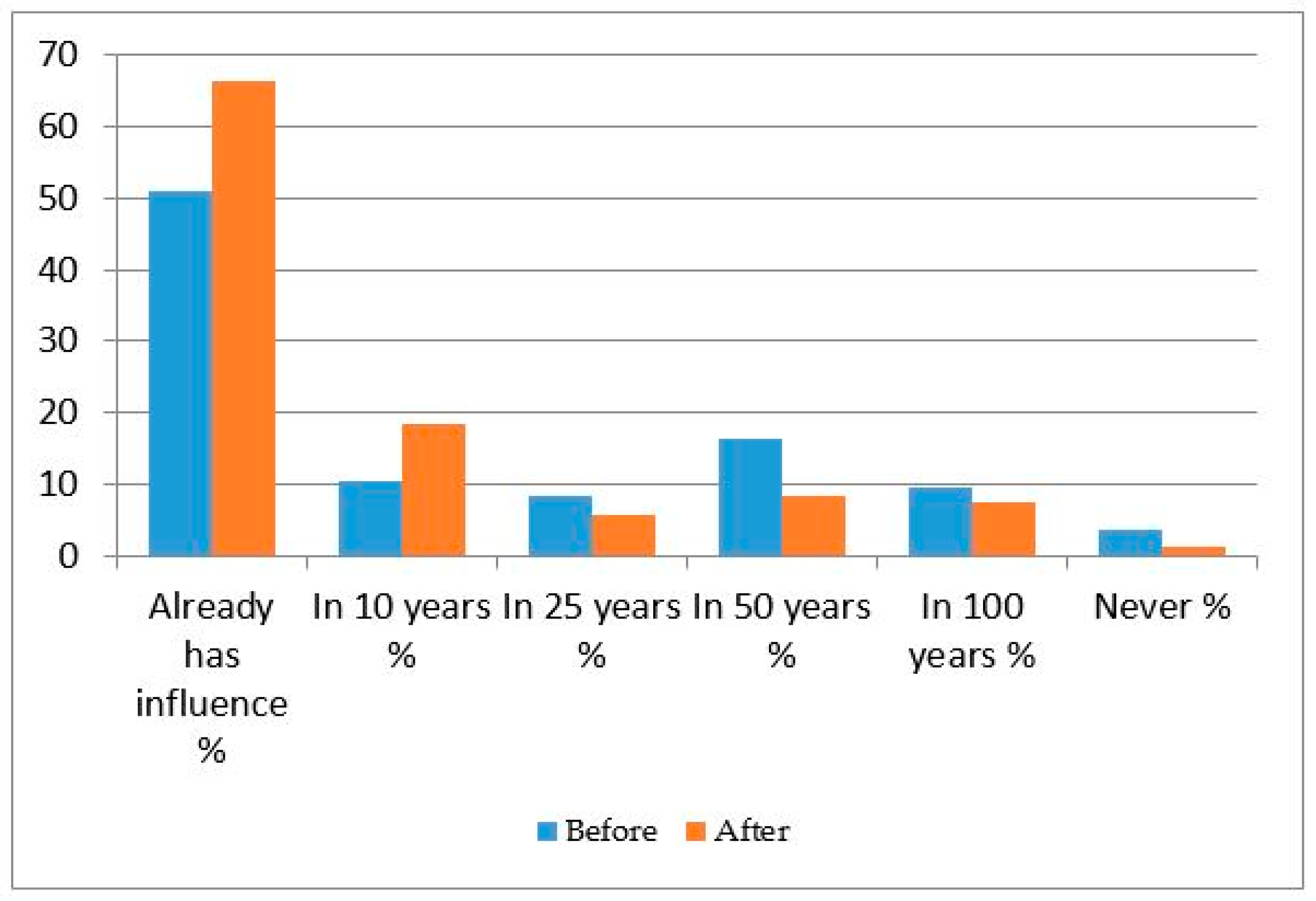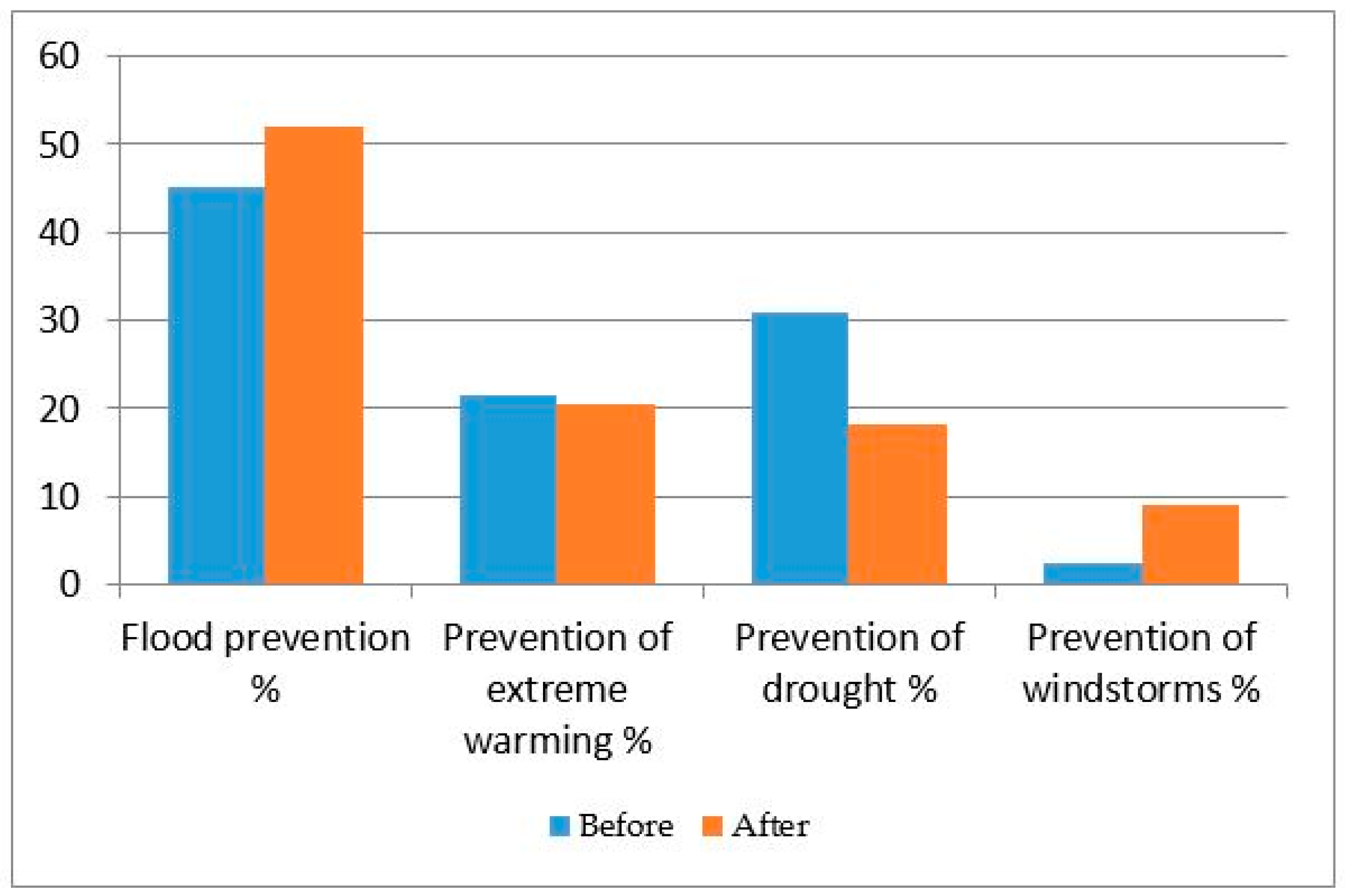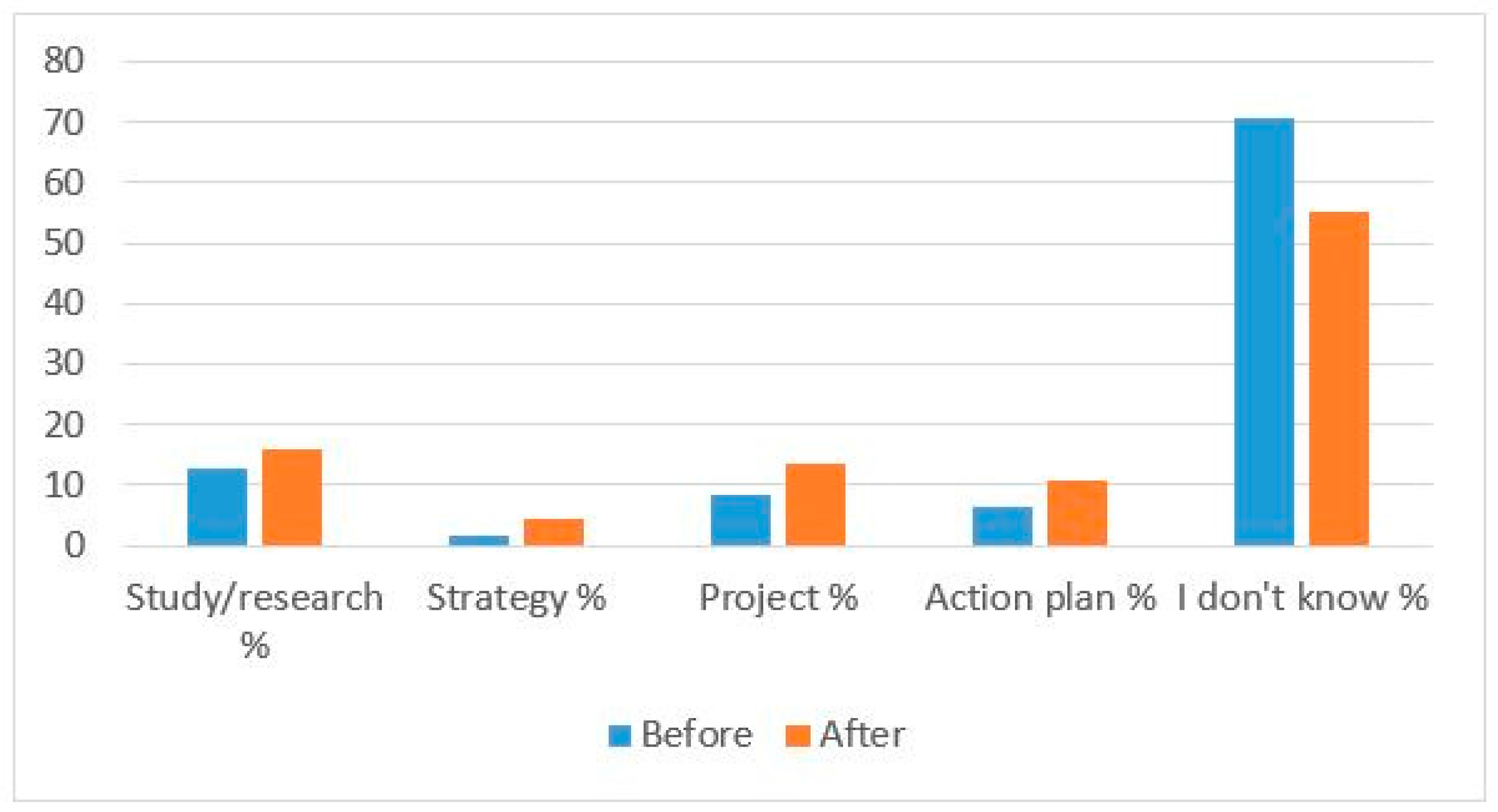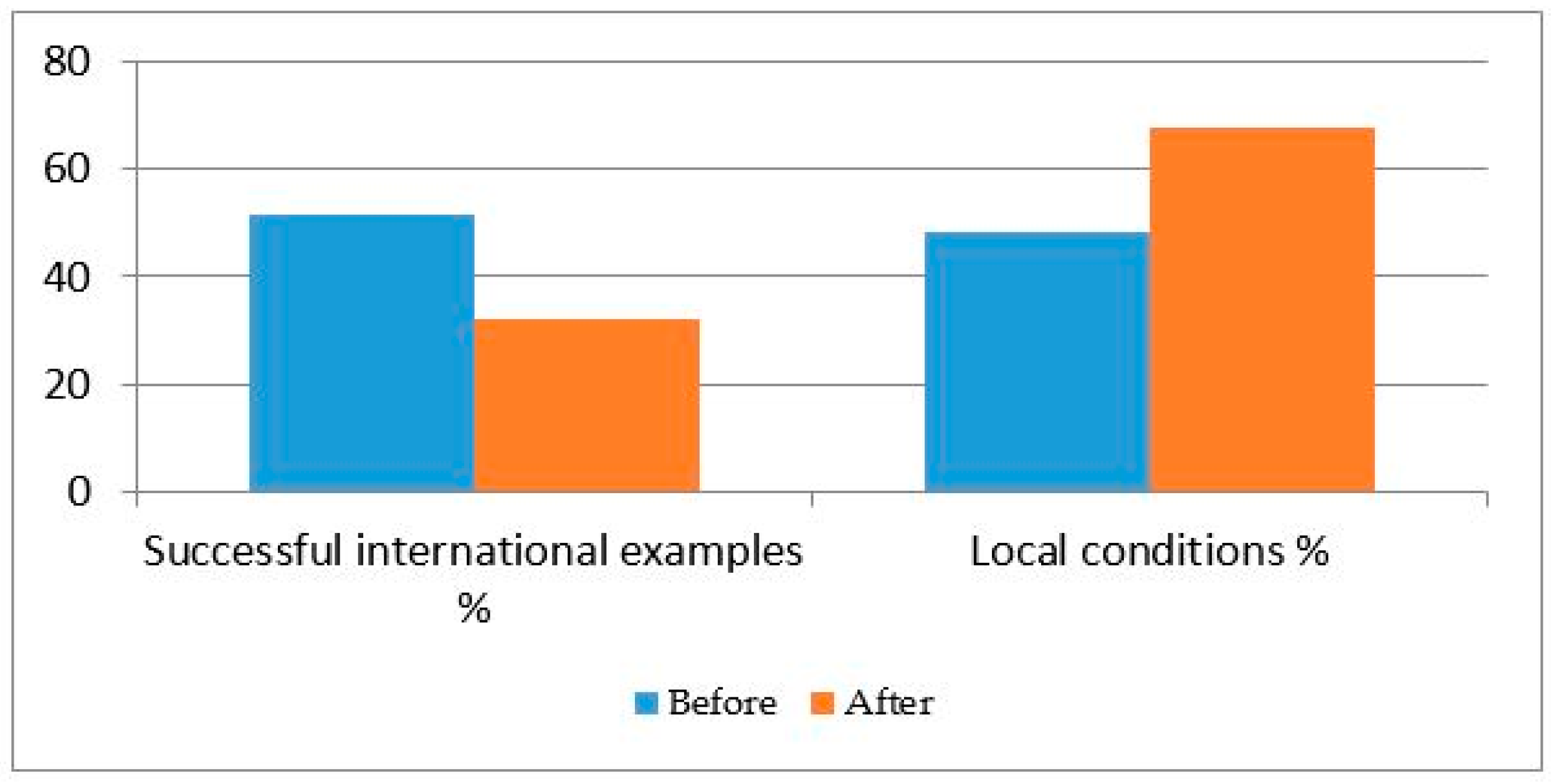3. Results: The Analysis of the Questionnaire
The following section will provide the interpretation of the results in relation to the initial hypothesis, i.e., how the acquired knowledge, obtained by PBL method, influenced students’ ability to understand climate change and react to its challenges. The data was collected before and after the course and was analyzed by the bivariate statistical method.
QN No. 1. The professional field of action that you are most interested in (
Figure 5):
The first question shows an increased interest in green architecture, after the course was completed (over 73.3% respondents). Simultaneously, the number of students who added another area of professional action increased, implying that the application of PBL method also stimulated their interest in environmental topics, focused on sustainable development and climate change.
QN No.2. Do you think that architects are able to do more than other professionals in order to reduce the sensitivity of urban structure and adapt it to climate change? (
Figure 6).
The responses to this question clearly demonstrate students’ awareness of the importance of their future profession regarding the sustainable development and climate change. 51.3% believe that architects can contribute as much as some other professionals, while 47.5% emphasized the ultimate importance of architects in environmental issues and climate change adaptation and mitigation.
QN No.3. Do you think that the topic of climate change is significant to your future work? (
Figure 7).
After the course, almost half of students (49.1%) considered the topic of climate change very important for their future work, while 22.3% described it as extremely important. Consequently, we can conclude that the knowledge transmitted during the course increased their environmental and professional awareness.
QN No.4. The importance of climate change in teaching at the Faculty of Architecture—rank from 1–5 (
Figure 8).
The required ranking (1—insufficient, 2—little, 3—moderate, 4—sufficient, 5—excellent) shows that after the course, 61% of students considered that the importance of climate change in teaching could be mostly classified from moderate (35.5%) to sufficient (32.5%), which is a certain improvement in accordance to pre-course opinion (little 46.7%, moderate 22.5%). In total, it could be concluded that PBL method improved the prevailing perception of students before the course.
QN No.5. What does the adaptation to climate change assume? (
Figure 9).
In this case, the participating students showed that they possess prior knowledge, which increased after the course. The post-course results reveal that 34.2% described climate change adaptation as the process of preparing for the impacts of climate factors, while 49.8% of them consider it as a way of providing resilience of natural systems.
QN No.6. How do you expect to improve your knowledge on climate change adaptation? (
Figure 10).
Considering the preferable learning method, most of the respondents find their own research as the most suitable one (22.7% before, 41.7% after the course) which confirms the activation of their interest, as well as the obtained tacit knowledge. 24.5% of all students opted for the communication with other students, while data related to lectures decreased from 35.5% to 19.5%. These data show the importance of interactive approach to climate change issues, based on continuous exchange and updating of knowledge and available information.
QN No.7. Rank skills (necessary for conducting the process of climate change adaptation) which you have obtained during the studies on the Faculty of Architecture (
Figure 11).
This question is focused on the relationship between experiential knowledge (Tacit and PBL) and ability to select the adequate methods for climate change adaptation in a specific context:
gained knowledge through PBL—items 1,5,6,8,9;
gained knowledge through application of other learning methods—items 2,3,4,7,8.
Considering the available results of the questionnaire, it is visible that the most important obtained skills are related to identification of risk/sensitivity/vulnerability (18.85%) and problem solving (14.79%). Consequently, respondents claim they received/adopted less knowledge through communication within a team (13.45%), argumentation (11.73%), critical evaluation of the results (11.39%) and learning from actual experiences (10.92%). The results also show that the issues of creativity and design should be better incorporated into the learning process, in order to stimulate genuine applicability of current environmentally sensitive theoretical concepts into practice.
QN No.8. During the education process at the Faculty of Architecture I received valuable knowledge in the field of climate change adaptation and mitigation (
Figure 12).
In general, the response to this question is very positive and encouraging when it comes to the growing ability of students to understand the effects of climate change in a specific context. Obviously, the experiential knowledge (PBL), obtained during the previous studies, increased environmental awareness and broadened the scope of information and skills related to the adaptation of built environment and environmental challenges. Respondents generally agree with the statement (18.5% before, 49.7% after), or partially agree (11.4% before, 16% after), while the share of those who totally disagree decreased from 26.9% to 1%.
QN No.9. Have you ever tried to find creative and innovative solutions in the field of planning and design, which would be sustainable and sensitive to climate change? (
Figure 13).
The results after the course reveal that students are better at relating to options that stimulate their creativity–such as architectural projects (34.9%), while urban concepts/urban design (12.6%) or obligatory essays (12%), also included into curriculum, have a lower impact. However, as many as 37.5% students have no experience in this area, and only 3% tested their knowledge and ideas in competitions. The situation was even worse before the course, with 45.1% of students without any interests or attempt to deal with environmentally challenging and climate sensitive topics.
QN No.10. Are you familiar with the various aspects of climate change adaptation? How did you obtain this knowledge? (
Figure 14).
This question gives an insight into the relationship between experiential knowledge (via practice) and ex-cathedra learning method (via theory). It is interesting to notice that the importance of the experiential knowledge increased from 37.2% to 69.97% which could be explained by the organization of the work at the course, as well as by the content of lectures which presented a number of up-to-date professional and theoretical information.
QN No.11. How do you decide about the solutions to the climate-sensitive problems? Please choose the option used in your own projects (
Figure 15).
The aim here was to relate the experiential knowledge (observing and analyzing the site and good practice) with the ability to solve climate sensitive spatial problems intuitively, via creative solutions determined by local background. Having in mind the selected methods of education (PBL, tacit knowledge), the largest share of respondents (34.5% before and 52.5% after the course) claimed they selected solutions following the criteria formulated by themselves. This result could be seen as an effect generated by the applied teaching/learning method during the course which stressed the importance of site-specific conditions. Approximately one fifth of students used the intuitive approach, while a significant share of respondents relied on the analogy with previous experiences (decrease from 23.3% to 12.5%). Meanwhile, 15.5% of students used the template, i.e., the ex-cathedra pre-formulated professional criteria (23.3% before the course).
QN No.12. When do you think that climate change will begin to affect life patterns in Serbia? (
Figure 16).
The most of the students showed they were informed and conscious about climate change effects (even before the course). 66.3% of respondents answered that climate change was already affecting life patterns in Serbia, 18.5% think that effects will be visible in 10 years, while 22.9% anticipated period of 25 and 50 years. Obviously, most students intuitively relate climate sensitive problems to space (PBL and Tacit Learning method), but their ability to understand climate change also increased after the course.
QN No.13. Which are the suitable examples of successful climate change adaptation in Serbia (add/name plans, projects, actions ...)? (
Figure 17).
When asked to add/list plans, projects or actions representing appropriate examples of successful climate change adaptation, most students, both before and after the course, specified cases related to flood prevention. That could be explained by the fact that the curricula in several previous courses included this topic, while the course Urban Structure used a research polygon exposed to flooding (the area of Ada Ciganlija). The prevention of windstorms was generally neglected as a possible area of interest/knowledge, although its share increased from 2.5% to 9.1%. These outcomes clearly show the relation between the applied/adequate educational methods and obtained knowledge on specific contextual problems.
QN No.14. Have you ever heard of any activity/research in Serbia focused on the reduction of climate vulnerability? (
Figure 18).
According to the outcome of this question, which tends to relate experiential knowledge (local experience) and the process of seeking creative solutions in a specific/local background, students are not familiar with local experiences and the research related to climate change adaptation and mitigation. Even though the share of informed students increased after the course, 55% of respondents were unaware of current Serbian practice, while some of them knew about certain projects (13.7%), action plans (10.9%), study /research (15.9%) and strategies (4.5% ).
QN No.15. In order to solve the problems associated with climate change you usually consider successful international examples or local conditions? (
Figure 19).
According to the collected answers, students expressed an understanding of local background, and 68% were prepared to adjust to local specific conditions (48.5% before the course), while only 32% preferred ready-made recipes/models. This significant decrease (from 51.5%) clearly demonstrates the relationship between the used teaching methodology (PBL, tacit learning) and the developing comprehension of specific local contexts and environmental challenges.
QN No.16. Do you see your involvement in solving problems related to climate change in the future professional work? In what way?
The information collected before and after the course show that 82.3% of students participated in certain activities related to the environmental issues and climate change challenges, comparing to 68.6% before the course. Obviously, the acquired knowledge on climate change influenced both a better understanding of the phenomena and the role which profession has in a current global setting, although the applicability of their knowledge still seems to be questionable and insufficient.
4. Discussion
The results of the conducted survey reveal the interdependence of the skills attained during the course Urban Structure and the applied PBL educational method. Most respondents have recognized two skills as necessary for adaptation to climate change-identifying risk and sensitivity of urban environment (18.85%) and focusing on solving specific problems associated with climate change (14.79%). Meanwhile, 13.45% emphasize the importance of obtaining knowledge through communication within the team, the argumentation of attitudes (11.73%), the critical evaluation of the results (11.9%) and learning from actual experiences (10.92%). Some of the students, however, underline an insufficient role of creativity (only 9.86%) and formal aspects (5.95%), which, in their opinion, should play a bigger part in the curriculum. Additionally, most respondents stated that their own research represents the most suitable approach to improving their knowledge on climate change adaptation, which confirms the concept of PBL and the thesis about activation of students’ interests of climate changes, as well as the necessity of enrolling them into professional practice. Consequently, 24.5% of students would like to improve their knowledge through communication with other students, through lectures (19.5%), while only 14.3% would rely on interaction with teaching assistants (14.3%).
When arguing about new knowledge that students gained on strategies for solving climate change in Serbia, a great majority of respondents did not agree that the adequate monitoring of climate factors is applied (42.2%). Additionally, 64.6% think that Serbia has not implemented different methods of climate change adaptation in the planning process. Students are also aware that an adequate information base on climate change does not exist (45.2%) but they are informed that certain standards and reports on the implementation of plans in Serbia are implemented (51.4%) (see table chart below QN No. 14–
Figure 18). These results might be explained by the fact that during the course they learned about the variety of activities on climate change adaptation.
Considering the success of the applied methods of education, the opinions were divided - 29.97% emphasized the role of theoretical knowledge, 27.48% preferred the teamwork for solving specific practical problems, while 25.16% of the subjects practiced individual approach or were acquainted with the problems in practice (17.39%). Furthermore, considering the learning method, the architectural project seems to be the most suitable and preferred in the climate change adaptation of urban structure (34.9%), for 12.6% it is urban design projects, while 12% find course essays as the best medium. However, 37.5% of students did not gain any experience related to climate challenges and only 3% participated in competitions with that focus. After the course which provided new information and enabled better merging of the climate problems and their professional treatment, 82.3% realized their professional role in solving problems related to climate change,44.1% were aware of their future engagement (although in a general sense), but only 38.2% considered themselves able to participate in defining the professional, detailed guidelines. Still, 17.7% of students did not recognize their professional engagement in the problem solving.
When considering methods of education (PBL, tacit knowledge), the highest percentage of respondents claimed that they adopted the solution by using the criteria that they formulated during the problem solving (52.5%, indicating the specificity of the problem and a unique approach to every problem). 19.5% of students worked intuitively and a significant number used the analogy with previous experiences (12.5%). Only 15.5% of students used the template/pattern or pre-formulated professional criteria.
The results of the survey support the claim that the application of PBL educational method in solving climate change adaptation problems stimulates students’ interest in acquiring new knowledge. It also successfully enables course participants to contribute to climate change adaptation of urban structure, which is especially important in the context of a developing country (Serbia), with limited resources, lower environmental consciousness and transitional legislation framework.
5. Conclusions
The presented analysis provides an insight into an emerging area of architectural education which introduces elements of the climate change adaptation and mitigation in the Problem Based Learning method, in the context of a developing country, with sensitive socio-economic and legislative backgrounds. The impact of recent efforts conducted at the University of Belgrade-Faculty of Architecture was tested during the course Urban Structure, revealing the initial effects on students’ perception of environmental problems which are still insufficiently included in the professional practice, general awareness and governmental mechanisms. Therefore, their inclusion in the university curriculum represents an important step in achieving higher level of integration between theoretical knowledge and challenges from the architectural and planning practice, which is certainly one of the long-term objectives of contemporary architectural education. Furthermore, the results obtained by a questionnaire may be used for indirect conclusions which would direct setting of new educational guidelines, supported by the agendas of referential institutions, e.g., RTPI (Royal Town Planning Institute) or EDUCATE—Framework for Curriculum Development Environmental Design in University Curricula and Architectural Training in Europe. Applied in developing countries (e.g., Serbia), they can provide a necessary adjustability of professional (re)actions in the context of uncertainty (in social, political, environmental and economic sense), leading to a more sustainable and resilient urban development and transformation.
The survey of the students’ perception of acquired knowledge and competences is interpreted in relation to student`s ability to understand climate change and its effects on environment, as one of immediate goals, and to seek creative solutions in specific contexts (both as immediate and long term goal). Through the analysis of the obtained results, it is confirmed that the education of architects, oriented towards the issues of climate change adaptation and mitigation, demands the application of alternative pedagogical models, especially Problem Based Learning method. Simultaneously, the perception of the problem(s) also changes after the application of these methods. In Problem Based Learning method, students face a problem which they have to understand completely and that motivates them to disclose relevant knowledge, without pre-determined models/recipes. This learning path is especially important in a specific local context which needs creative solutions to complex problems caused by climate change, but faces different types of limitations on all spatial and governmental levels.
Problem Based Learning method certainly stimulates a more powerful experience than the application of abstract knowledge and general models, but several dilemmas remain. For example, when is the right moment to detect and expose a problem and research question—before, after, or during the process of acquiring knowledge about the site? If the research question is posed after adopting knowledge, an opportunity to shape the creative abilities of students will be missed. However, exposing a problem too early might discourage students, or push them to give incorrect answers which are not based on accurate information. Therefore, formulating a research question in the right moment is crucially important for the momentum of learning process because it helps students shape their opinion on the relationship between urban environment and climate change, sustainable mechanisms and preferred scenarios of problem solving. Finally, the special value of this teaching method could be found in a problem-oriented work. As a result, students avoid using generalized solutions but produce specific design proposals and ground rules for land use. Adjusting to local conditions, they remain open and flexible for the necessary iterations during the design and planning process, generated by circumstances and continuous upgrading of knowledge, experiences and innovations.
